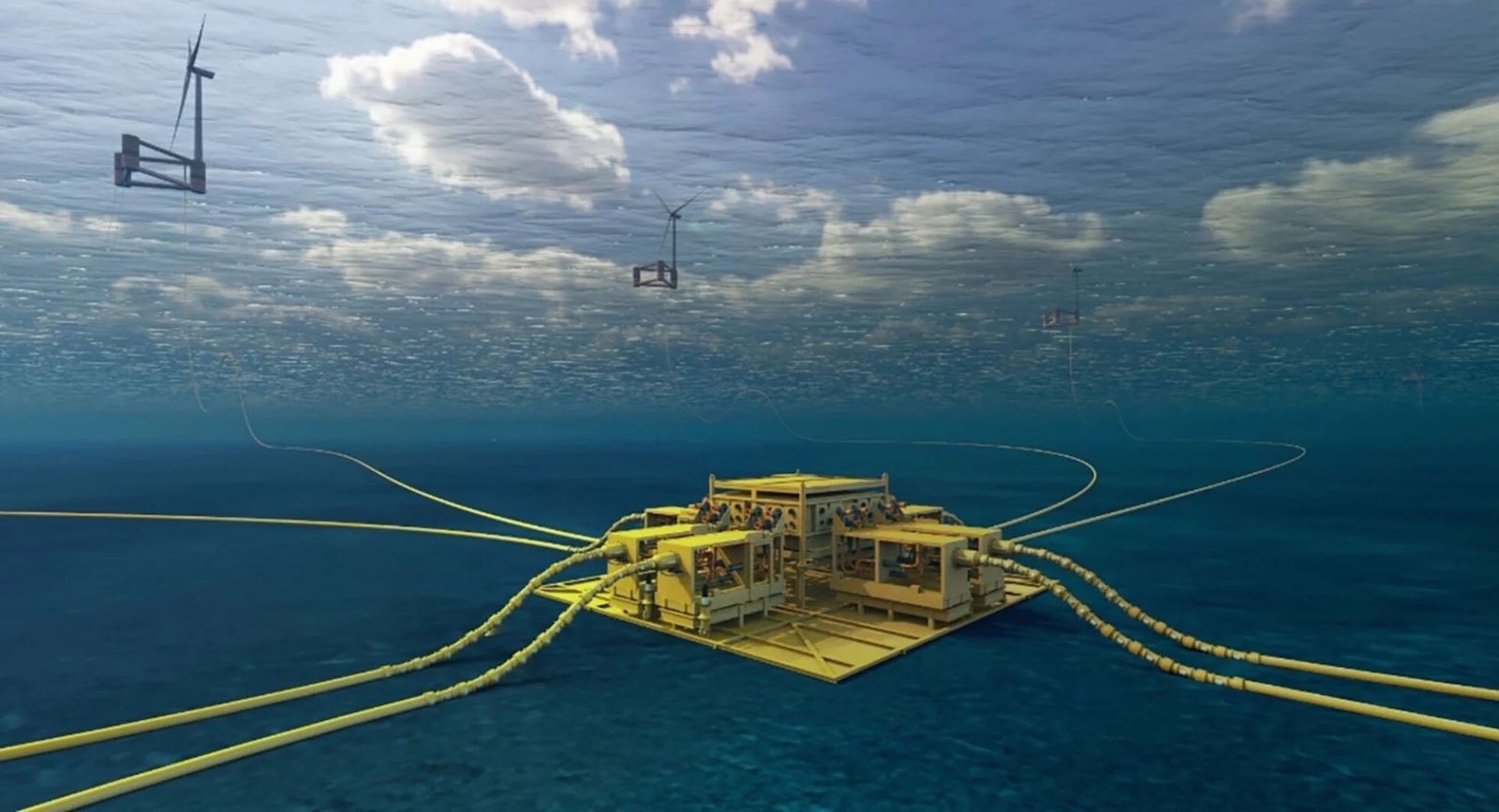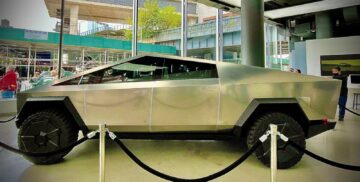
Sign up for daily news updates from CleanTechnica on email. Or follow us on Google News!
The US is depending on floating wind turbine technology to get its hands on more offshore wind resources. However, floating wind is a relatively new industry and costs tend to run higher, compared to the more familiar offshore wind turbines that sit on high towers fixed to the seabed. Fortunately, solutions have been emerging, and it looks like a key goal is already within reach.
How Low Should Floating Wind Go?
If you’re wondering why not just build more offshore wind turbines that are fixed to the bottom, that’s a good question. Conventional fixed-bottom construction is uneconomical and impractical in deep waters. That cuts out much of the US west coast for offshore development, among other parts.
“About two-thirds of U.S. offshore wind energy potential exists over waters too deep for today’s fixed-bottom wind turbine foundations secured directly to the sea floor, and instead require floating platforms,” explains the US Department of Energy.
“Floating offshore wind is key to transitioning dense population centers to clean energy, and would also mean thousands of jobs in wind manufacturing, installation, and operations,” they add, meaning that it would be awfully convenient for large coastal cities to suck clean kilowatts from nearby wind farms in the ocean, rather than building new transmission lines for onshore wind farms.
That’s all well and good, except floating wind turbines are pricey. The Energy Department estimates that a commercial-scale floating wind farm costs 50% more than a comparable fixed-bottom array.
According to the Energy Department’s calculations, about $45 per megawatt-hour would be the sweet spot for the cost of floating offshore wind. We’re nowhere near that. Costs need to come down by more than 70%, and the Energy Department wants to accomplish that by 2035.
On the bright side, things are already moving along in the right direction. The US Department of the Interior, for example, seems pretty sure that floating technology will be cost-competitive…eventually.
“There are no major cost components for floating wind that indicate floating wind will be more expensive than conventional fixed-bottom offshore wind in the long term,” reports the agency’s Bureau of Ocean Energy Management.
BOEM has been scouting the Oregon coast for floating wind opportunities. Their latest offshore wind “heat map” indicates that parts of the coast are getting close to competitive in terms of the levelized cost of energy, which is a calculation that provides a point of comparison between different kinds of energy resources.
“The LCOE values range from about $75/MWh (7.5 ₵/kWh) in the north to about $50/MWh (5.0 ₵/kWh) in the south,” they report.
The Starfish Solution
Fifty dollars per megawatt-hour comes pretty close to the goal, but close does not win the cigar. Also, that figure of $50/MWh only applies to a small part of the Oregon coast.
CleanTechnica has spotted some interesting cost-cutting solutions over the past couple of years that could help expand the field of options (see more coverage here). Another one just crossed our radar, in the form of a starfish-shaped, undersea configuration for offtaking electricity from floating wind turbines.
The Norwegian company Aker Solutions is the company behind the new setup, which they’re calling Subsea Collector. That’s particularly interesting because Aker cut its teeth in the oil and gas industry, and it is one of the many stakeholders applying its offshore know-how to the renewable energy revolution.
Norway’s METCentre innovation hub anticipates that the Subsea Collector will be a game-changer.
“This pioneering project will contribute to shaping the infrastructure in future large scale floating wind parks,” explains METCentre CEO Arvid Nesse, adding that “the project demonstrates how Norwegian subsea expertise from the oil and gas industry drives innovation forward within floating offshore wind on a global scale.”
In a conventional offshore wind farm, the offtake cables connect the turbines in a sort of daisy chain. Aker came up with a new star-shaped arrangement that provides wind farm developers with a wider set of design and construction options.
Aker states that the new design reduces the amount of cable required, compared to conventional daisy-chain hookups. As another cost-cutter, the star configuration reduces installation costs, particularly in the area of the time spent by vessels and crews at sea. All in all, Aker anticipates a savings of up to 10% for a 1-gigawatt wind farm.
One Floating Platform To Rule Them All
The METCentre is hosting a pilot test of the Subsea Collector, beginning with two wind turbines currently at the site. That’s not quite enough points to make up a star, but another five turbines will be added by 2026.
While we’re waiting for that to happen, we also spotted another new cost-cutting solution.
This one involves cutting the cost of the portside facilities needed to fabricate and assemble floating platforms, teaming up the London-based floating platform innovator Gazelle Wind Power with the UK dry dock innovator Tugdock.
Tugdock’s signature product is described as the “world’s first road-transportable floating dry dock.” The system is designed as a turnkey solution that overcomes portside fabrication barriers. Instead of a costly rearrangement of the port’s facilities, the system acts as a sort of RV for visiting relatives. They can just pull up into the driveway with a minimum of fuss and bother, and pull out before everyone gets tired of them.
Gazelle explains that “there are significant benefits to assembling the modules on the Tugdock platform, which doubles as the assembly fixture and launch method, speeding up platform assembly and getting our platform into the water in a safe, and cost-effective way.”
On their part, Gazelle has come up with a modular system that also works around the need for an expensive port makeover. The modules are designed to be fabricated at a shipyard, then brought to a port near the wind farm for final assembly and launch.
So, How Low Can Floating Wind Go?
We’ll have to wait and see about that new approach, too. The Gazelle-Tugdock partnership will get its first full scale deployment in 2028, for the construction of Italy’s Molise Offshore Wind Farm in the Adriatic Sea. The 1.05-gigawatt array will sport 70 floating wind turbines.
Meanwhile, yet another cost-cutting solution has emerged from the halls of the Lawrence Berkeley National Laboratory in California. A Berkeley Lab team has been exploring the use of fiber-optic sensing technology to reduce the cost of inspecting and monitoring floating offshore arrays. The monitoring system would also catch potential trouble before it happens, avoiding repair costs and down time.
The Berkeley Lab project is aimed at harvesting optimal wind speeds in deep waters of 1,000 meters or more, where no floating wind turbine has gone before. Researchers are already studying the potential environmental impacts and mitigation strategies for deepwater deployment.
The research team anticipates that their work on fiber-optic sensors will lend an assist to environmental data collection. Developing hardier, more resilient materials for floating wind turbines in deep water is also part of the plan.
Follow me @tinamcasey on Bluesky, Threads, Post, and LinkedIn.
Image: New star-like cable arrangement for floating offshore wind farms, courtesy of Aker Solutions.
Have a tip for CleanTechnica? Want to advertise? Want to suggest a guest for our CleanTech Talk podcast? Contact us here.
Our Latest EVObsession Video
[embedded content]
I don’t like paywalls. You don’t like paywalls. Who likes paywalls? Here at CleanTechnica, we implemented a limited paywall for a while, but it always felt wrong — and it was always tough to decide what we should put behind there. In theory, your most exclusive and best content goes behind a paywall. But then fewer people read it!! So, we’ve decided to completely nix paywalls here at CleanTechnica. But…
Thank you!
Advertisement
CleanTechnica uses affiliate links. See our policy here.
- SEO Powered Content & PR Distribution. Get Amplified Today.
- PlatoData.Network Vertical Generative Ai. Empower Yourself. Access Here.
- PlatoAiStream. Web3 Intelligence. Knowledge Amplified. Access Here.
- PlatoESG. Carbon, CleanTech, Energy, Environment, Solar, Waste Management. Access Here.
- PlatoHealth. Biotech and Clinical Trials Intelligence. Access Here.
- Source: https://cleantechnica.com/2024/01/07/giant-subsea-starfish-floating-offshore-wind-costs/
- :has
- :is
- :not
- :where
- $UP
- 000
- 1
- 15%
- 2026
- 2028
- 36
- 7
- 70
- a
- About
- accomplish
- acts
- add
- added
- adding
- Advertise
- Affiliate
- aimed
- All
- along
- already
- also
- always
- among
- amount
- an
- and
- Another
- anticipates
- applies
- Applying
- approach
- ARE
- AREA
- around
- arrangement
- Array
- AS
- Assembly
- assist
- At
- avoiding
- barriers
- BE
- because
- been
- before
- Beginning
- behind
- benefits
- Berkeley
- BEST
- between
- Bit
- bluesky
- Bottom
- Bright
- brought
- build
- Building
- Bureau
- but
- by
- cable
- cables
- calculation
- calculations
- california
- calling
- came
- CAN
- Catch
- Centers
- chain
- chip
- cigar
- Cities
- clean
- cleantech
- Cleantech Talk
- Close
- Coast
- coastal
- collection
- collector
- come
- comes
- Companies
- company
- comparable
- compared
- comparison
- competitive
- completely
- components
- Configuration
- Connect
- construction
- content
- contribute
- Convenient
- conventional
- Cost
- cost-effective
- costly
- Costs
- could
- Couple
- coverage
- Crossed
- Currently
- Cut
- cuts
- cutting
- data
- decide
- decided
- deep
- demonstrates
- dense
- Department
- Department of Energy
- Depending
- deployment
- described
- Design
- designed
- developers
- developing
- Development
- different
- direction
- directly
- Dock
- does
- dollars
- don
- doubles
- down
- dry
- electricity
- embedded
- emerged
- emerging
- energy
- enough
- environmental
- estimates
- everyone
- example
- Except
- Exclusive
- exists
- Expand
- expensive
- expertise
- Explains
- Exploring
- facilities
- familiar
- farm
- Farms
- felt
- fewer
- field
- Figure
- final
- First
- five
- fixed
- floating
- Floor
- For
- form
- Fortunately
- Forward
- Foundations
- from
- full
- future
- game-changer
- GAS
- get
- getting
- giant
- Global
- global scale
- Go
- goal
- Goes
- gone
- good
- Guest
- Hands
- happen
- happens
- Harvesting
- Have
- help
- here
- High
- higher
- hosting
- How
- However
- HTTPS
- Hub
- if
- Impacts
- implemented
- in
- indicate
- indicates
- industry
- Infrastructure
- Innovation
- Innovator
- installation
- instead
- interesting
- interior
- into
- involves
- IT
- ITS
- Jobs
- jpg
- just
- Key
- lab
- laboratory
- large
- latest
- launch
- lawrence
- LEND
- like
- likes
- Limited
- lines
- links
- Long
- LOOKS
- Low
- major
- make
- management
- manufacturing
- many
- materials
- me
- mean
- meaning
- Media
- method
- minimum
- mitigation
- modular
- Modules
- monitoring
- more
- most
- moving
- much
- National
- Near
- Need
- needed
- New
- news
- no
- North
- Norwegian
- ocean
- of
- Offshore Wind Turbines
- Oil
- Oil and Gas
- on
- ONE
- only
- Operations
- opportunities
- optimal
- Options
- or
- Oregon
- Other
- our
- out
- over
- parks
- part
- particularly
- Partnership
- parts
- past
- People
- per
- pilot
- Pioneering
- plan
- platform
- Platforms
- plato
- Plato Data Intelligence
- PlatoData
- player
- podcast
- Point
- points
- policy
- population
- Portside
- Post
- potential
- power
- pretty
- Product
- project
- provides
- publish
- Push
- put
- question
- quite
- radar
- range
- rather
- reach
- Read
- Reader
- reduce
- reduces
- relatively
- relatives
- Renewable
- renewable energy
- repair
- report
- Reports
- require
- required
- research
- researchers
- resilient
- Resources
- Revolution
- right
- Rule
- Run
- s
- safe
- Savings
- Scale
- SEA
- Secured
- see
- seems
- sensors
- set
- setup
- shaping
- should
- side
- signature
- significant
- sit
- site
- small
- So
- solution
- Solutions
- some
- South
- speeds
- spent
- Sport
- Spot
- stakeholders
- Star
- Starfish
- States
- Stories
- strategies
- Studying
- suggest
- support
- sure
- sweet
- system
- T
- Talk
- team
- teaming up
- Technology
- term
- terms
- test
- than
- that
- The
- The Area
- the UK
- their
- Them
- then
- theory
- There.
- they
- things
- thousands
- time
- tip
- tired
- to
- today’s
- too
- tough
- transitioning
- trouble
- turbine
- turnkey
- two
- two-thirds
- u.s.
- Uk
- Updates
- us
- use
- uses
- Values
- Ve
- vessels
- Video
- wait
- Waiting
- want
- wants
- was
- Water
- Waters
- Way..
- we
- WELL
- West
- What
- which
- while
- WHO
- why
- wider
- will
- win
- wind
- wind energy
- wind farms
- wind power
- wind turbine
- with
- within
- wondering
- Work
- works
- would
- write
- Wrong
- years
- yet
- you
- Your
- youtube
- zephyrnet



